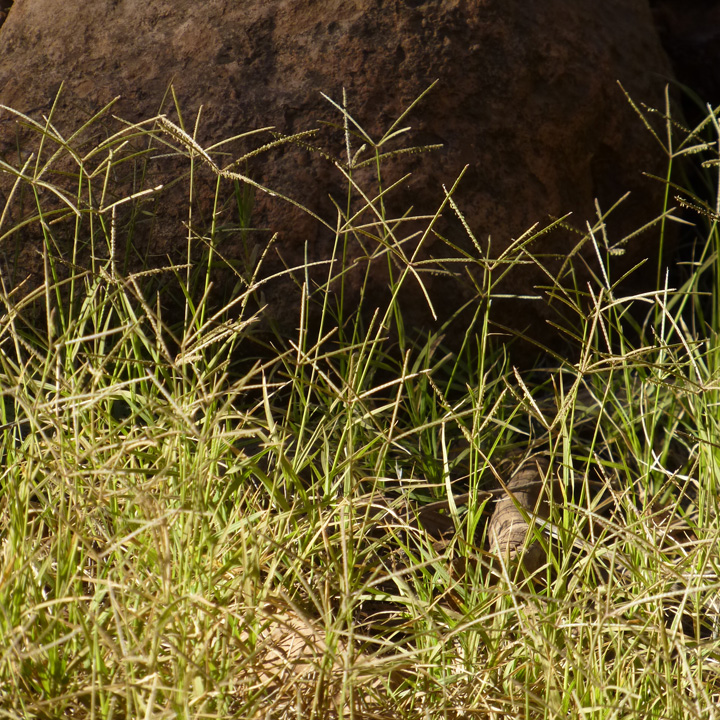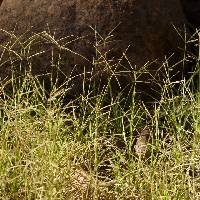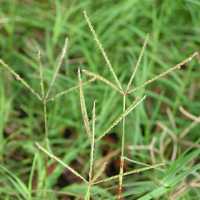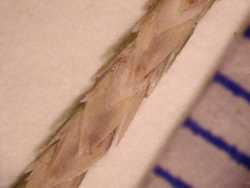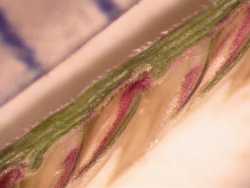Plants stoloniferous, usually also rhizomatous. Culms 5-40(50) cm, not becoming woody. Sheaths glabrous or with scattered hairs; collars usually with long hairs, particularly at the margins; ligules about 0.5 mm, of hairs; blades 1-6(16) cm long, (1)2-4(5) mm wide, flat at maturity, conduplicate or convolute in bud, glabrous or the adaxial surfaces pilose. Panicles with (2)4-6(9) branches; branches 2-6 cm, in a single whorl, axes triquetrous. Spikelets 2-3.2 mm. Lower glumes 1.5-2 mm; upper glumes 1.4-2.3 mm; lemmas 1.9-3.1 mm, keels not winged, pubescent, margins usually less densely pubescent; anthers dehiscent at maturity; paleas glabrous. 2n = 18, 36.
Cynodon dactylon is a variable species, but taxonomists disagree on just how variable. Caro and Sánchez (1969) limited C. dactylon to plants with conduplicate leaves, placing those with convolute leaves in a number of other species, such as C. affinis Caro & Sánchez and C. aristiglumis Caro & Sánchez; de Wet and Harlan (1970) do not mention this character in their study of Cynodon. Caro and Sánchez also employed several other characters in the key separating C. dactylon from the species with convolute immature leaves, but the overlap between the two sides of the lead is substantial. Pending further study, the broader interpretation, in which C. dactylon includes plants with both convolute and conduplicate leaves, has been adopted.
Several varieties of C. dactylon have been described, in addition to which numerous cultivars have been developed, some as turf grasses for lawns or putting greens, others as pasture or forage grasses. Their useful range is limited because C. dactylon is not cold hardy, going dormant and turning brown when nighttime temperatures fall below freezing or average daytime temperatures are below 10° C.
The most commonly encountered variety, both in the Flora region and in other parts of the world, is C. dactylon var. dactylon, largely because it thrives in severely disturbed, exposed sites; it does not invade natural grasslands or forests. Determining how many other varieties are established in the Flora region is almost impossible, because there has been no global study of variation in the species. The presence of numerous cultivars complicates an already difficult problem. The two varieties keyed out below are the only two that grow in the Flora region according to de Wet and Harlan (1970), but these authors do not appear to have considered the taxa recognized by Caro and Sánchez (1969). For most purposes, it is probably neither necessary nor feasible to identify the variety of C. dactylon encountered.
Cynodon dactylon is considered a weed in many countries and it is true that, once established, it is difficult to eradicate. It does, however, have some redeeming values. It is rich in vitamin C, and its leaves are sometimes used for an herbal tea. It is claimed to have various medicinal properties, but these have not been verified. It is considered a good pasture grass, in addition to which it is sometimes grown as an ornamental and for erosion control on exposed soils.
Perennials, Terrestrial, not aquatic, Rhizomes present, Rhizome elongate, creeping, stems distant, Stolons or runners present, Stems trailing, spreading or prostrate, Stems nodes swollen or brittle, Stems geniculate, decumbent, or lax, sometimes rooting at nodes, Stems mat or turf forming, Stems terete, round in cross section, or polygonal, Stem nodes bearded or hairy, Stem internodes hollow, Stems with infloresce nce less than 1 m tall, Stems, culms, or scapes exceeding basal leaves, Leaves mostly cauline, Leaves conspicuously 2-ranked, distichous, Leaves sheathing at base, Leaf sheath mostly open, or loose, Leaf sheath smooth, glabrous, Leaf sheath hairy, hispid or prickly, Leaf sheath and blade differentiated, Leaf blades linear, Leaf blades 2-10 mm wide, Leaf blades mostly flat, Leaf blade margins folded, involute, or conduplicate, Leaf blades mostly glabrous, Leaf blades more or less hairy, Ligule present, Ligule a fringe of hairs, Inflorescence terminal, Inflorescence solitary, with 1 spike, fascicle, glomerule, head, or cluster per stem or culm, Inflorescence a panicle with narrowly racemose or spicate branches, Inflorescence a panicle with digitately arranged spicate branches, Inflorescence with 2-10 branches, Inflorescence branches 1-sided, Lower panicle branches whorled, Inflorescence branches paired or digitate at a single node, Rachis dilated, flat, central axis to which spikelets are attached, Rachis angular, Flowers bisexual, Spikelets sessile or subsessile, Spikelets laterally compressed, Spikelet less than 3 mm wide, Spikelets with 1 fertile floret, Spikelets solitary at rachis nodes, Spikelets all alike and fertille, Spikelets bisexual, Spikelets disarticulating above the glumes, glumes persistent, Spikelets secund, in rows on one side of rachis, Rachilla or pedicel glabrous, Glumes present, empty bracts, Glumes 2 clearly present, Glumes equal or subequal, Glumes distinctly unequal, Glumes shorter than adjacent lemma, Glumes keeled or winged, Glumes 1 nerved, Lemma coriaceous, firmer or thicker in texture than the glumes, Lemma 3 nerved, Lemma body or surface hairy, Lemma apex acute or acuminate, Lemma awnless, Lemma margins thin, lying flat, Lemma straight, Palea present, well developed, Palea membranous, hyaline, Palea about equal to lemma, Palea 2 nerved or 2 keeled, Stamens 3, Styles 2-fid, deeply 2-branched, Stigmas 2, Fruit - cary opsis.
Perennial mat-forming, runner-bearing herb, usually with rhizomes 5 cm - 0.56 m tall
Leaves: with open and hairless to sparsely hairy sheaths, long-haired collars, and ligules made of hairs about 0.5 mm long. The blades are 1 - 16 cm long, 1 - 5 mm wide, folded lengthwise or rolled up longitudinally in bud, becoming flat when mature, and hairless or minutely hairy on the upper surface.
Inflorescence: of two to nine branches borne in a whorl, each branch 2 - 6 cm long, with spikelets arranged in two rows on one side of the branch.
Fruit: a caryopsis.
Culm: 5 - 50 cm long, erect to ascending.
Spikelets: 2 - 3.2 mm long and laterally compressed.
Glumes: nearly equal, membranous and longitudinally ridged, the lower glume 1.5 - 2 mm long and single veined, the upper glume 1.4 - 2.3 mm long and one- to three-veined.
Florets: with three anthers and a style with two feather-like branches.
Lemma: 1.9 - 3.1 mm long, longitudinally ridged, three-veined, hairy but becoming sparsely so at the margins.
Palea: about same length as the lemma, hairless, with two longitudinal ridges.
Similar species: No information at this time.
Flowering: early July to mid October
Habitat and ecology: introduced from Africa, this species is rare in most of the region but is becoming frequent in lawns, parkways and vacant sandy lots of Barrien County.
Occurence in the Chicago region: non-native
Etymology: Cynodon comes from the Greek words cyon, meaning dog, and odus, meaning tooth, referring to the close rows of tooth-like spikelets. Dactylon means "with fingers."
Author: The Morton Arboretum
This grass has become sparingly established in the state and I predict that in time it will become a grass used frequently for lawns and pasturage. It thrives well in sandy soil where bluegrass will not. In a waste, vacant lot in Bluffton, Wells County, two large colonies have been established for several years and these were not injured by a temperature of twenty-one degrees below zero of the winter of 1935-1936.
Common Name: Bermudagrass
Duration: Perennial
Nativity: Non-Native
Lifeform: Graminoid
General: Perennial with stolons and rhizomes, stems mostly creeping and stoloniferous with short internodes, forming extensive mats.
Vegetative: Sheaths glabrous or with scattered hairs; leaves 2-ranked (emerging out of both sides of the culm in a single plane), flat, short, narrow, usually 1-6 cm long and 1-3 mm broad; ligule a fringe of short hairs and lateral tufts of long stiff hairs.
Inflorescence: Spikes 4-7, digitate, slender, 2.5-6 cm, purplish to green; spikelets sessile and closely appressed, in two rows on narrow, triangular rachis. Spikelets with with a single perfect floret, the rachilla extending beyond the palea and sometimes bearing a rudimentary lemma. Glumes lanceolate, awnless, subequal, and shorter than the lemmas; lemmas acute, awnless, keeled, pubescent, with a ciliate midnerve.
Ecology: Widespread weed; especially frequent along streams and in riparian zones; 0-6,000 ft (0-1829 m).
Distribution: Native to the Old World; naturalized worldwide.
Notes: One of the most common introduced grasses in Arizona. It is the most common cultivated lawn grass in the southwest-s low desert cities, and has become well established along most waterways in Arizona. It can be a valuable forage grass in desert environments, as it tolerates hot, arid, saline conditions. Distinguished by its perennial, stoloniferous and rhizomotous growth habit with culms and runners creeping long distances, becoming tangled, and producing dense growth and forming beds or mats in the right conditions. The inflorescence is distinct, too, with a panicle of 2-9 digitate branches with spikelets densely packed in 2 rows and florets containing pubescent lemmas and lacking awns. Another widespread weed, Chloris virgata, has a similar digitate inflorescence. However C. virgata is an annual grass with awned spikelets, while C. dactylon is perennial and awnless.
Ethnobotany: In India, juice pressed from the leaves, seeds, and flowers is mixed with sugar and taken for nausea.
Etymology: Cynodon is from Greek meaning dog-s tooth, a traditional common name for the grass in Europe; and dactylon is from Greek daktylos, or finger, referring to the digitate inflorescence.
Synonyms: Capriola dactylon, Panicum dactylon
Editor: SBuckley 2010, FSCoburn 2014, AHazelton 2015
Widely spreading by stolons and rhizomes and forming mats, the culms erect or ascending, 1-3 dm; main lvs 2-4 mm wide; spikes 4-6, divergent, 3-5(-8) cm; glumes 1.5-2.2 mm, the first curved, the second nearly straight; lemma 2-2.5 mm, minutely pubescent to long-villous on the keel; 2n=36, 40. Native of the Old World, abundant (and often cult.) in lawns and in disturbed sites in s. U.S. (n. to Del.) and adventive n. to N. Engl., Mich., and Nebr. (Capriola d.)
Gleason, Henry A. & Cronquist, Arthur J. 1991. Manual of vascular plants of northeastern United States and adjacent Canada. lxxv + 910 pp.
©The New York Botanical Garden. All rights reserved. Used by permission.


